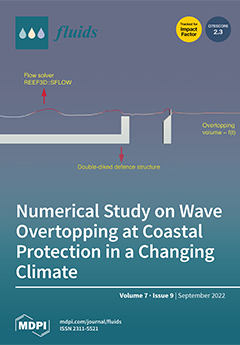Isothermal turbulent flow around circular cylinders arranged side-by-side was numerically simulated on a commercial finite-volumes platform, ANSYS
® CFX, version 2020 R2. The turbulence was modeled by using k-
ω shear stress transport (k-ω SST). Three different Reynolds numbers were computed,
Red
[...] Read more.
Isothermal turbulent flow around circular cylinders arranged side-by-side was numerically simulated on a commercial finite-volumes platform, ANSYS
® CFX, version 2020 R2. The turbulence was modeled by using k-
ω shear stress transport (k-ω SST). Three different Reynolds numbers were computed,
Red = 200, 1000, and 3000, which were based on the cylinder diameter, d, the free stream velocity,
U∞, and the kinematic viscosity of the fluid, ν. Sided cylinders were spaced apart from each other, forming a
p/d ratio equal to 2, which was kept constant throughout the computations regardless of changes in the Reynolds number. The drag coefficient,
Cd, as well as its time traces, was evaluated along with the different wake topologies experienced by the cylinders (wide wake
WW and narrow wake
NW). The simulations were able to predict the bistable flow over the cylinders and the Cd changes associated with the wakes. Whenever a new wake topology was identified, the shape drag changed in accordance with the instantaneous pressure distribution. A laminar simulation was carried out for the lowest Reynolds number case, showing that the adopted turbulence model did not affect the dynamic response of the flow. The
Red = 3000 case was compared to Afgan’s outcomes, whose simulations were carried out in a 3-D mesh using LES (Large Eddy Simulation), showing great agreement with their results.
Full article





